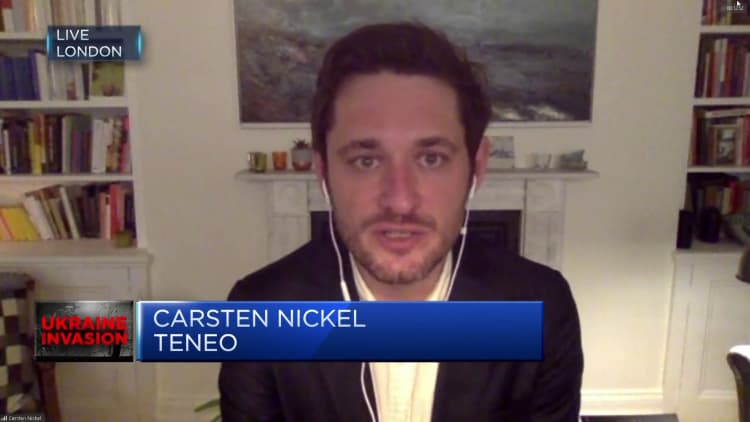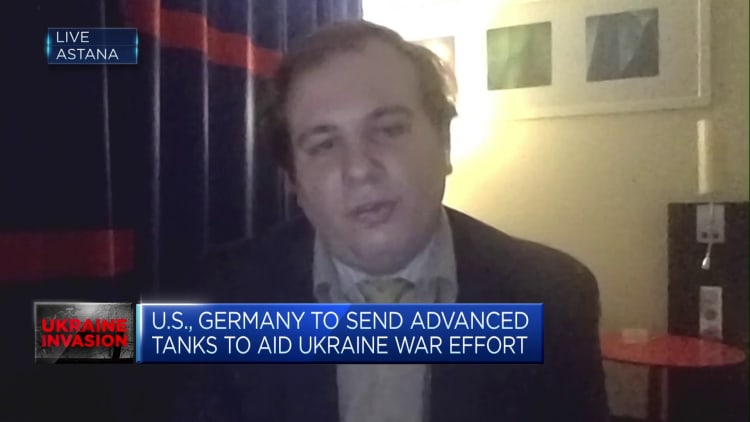
A Polish Leopard 2PL tank fires during Defender Europe 2022 military exercise of NATO troops including French, American, and Polish troops, amid the Russian invasion of Ukraine, at the military range in Bemowo Piskie, near Orzysz, Poland May 24, 2022.
Kacper Pempel | Reuters
Developments in the Ukraine war this week centered on an agreement from Germany and the U.S. who have finally decided to send dozens of their own respective battle tanks to the war-torn nation.
There was delight in Kyiv, with officials saying it could be a game changer in the conflict, and anger in Moscow with officials there calling the latest NATO donation “extremely dangerous.”
For Ukraine, the offer of modern, Western battle tanks was a long-time coming; it has requested Leopard 2 tanks from Germany, and asked Berlin to authorize their re-export from other allies, for months.
Widely available and used by a handful of armed forces in Europe today, Leopard 2s have been a stalwart for the German Army since they entered service in 1979 — with various upgrades since their inception (the latest version is the Leopard 2A7A1) — and have been used by Western nations in conflicts ranging from Kosovo to Afghanistan and Syria.
On Wednesday, Germany offered Ukraine 14 of its Leopard 2A6 tanks and said it would allow allies to export their own German-made tanks to Ukraine.

Poland, the Netherlands, Spain, Norway and Finland are among the other countries that have signaled they will, or are willing, to send tanks to Kyiv. The U.K. has already said it will send 14 of its Challenger 2 tanks while the U.S. said it would send 31 M1 Abrams tanks.
Yuriy Sak, an advisor to Ukraine’s Defense Minister Oleksiy Reznikov, explained to CNBC why Western tanks are a great fit for Ukraine, saying it would lead to better efficiency for the country’s fighters on the battlefield.
“They have better armor, they have longer firing range, they are more maneuverable. There are so many advantages. They can conduct night warfare because they’re equipped with night-vision systems for targeting, and enemies’ identification. So it’s very obvious that we will just be more efficient, and we will be able to achieve the same results with fewer losses on the side of our army,” he said.
The Leopard 2s are seen as a particular boon to Ukraine as they are relatively easy to maintain (particularly when compared to the advanced Abrams tank). They run on readily-available diesel and, most of all, a lot of Ukraine’s European neighbors have them and are ready to send them to Kyiv.
Jon Hawkes, author of the Tanknology blog, noted that one of the biggest attractions of the Leopard 2 tanks was that, theoretically, there was a large number of potential donors, noting on Twitter that “the advantage of Leopard 2 is, conceptually, everyone gives a modest number and Ukraine ends up with lots.”
Ukraine is certainly focusing right now on the exact number of tanks it can expect from its Western allies. President Volodymyr Zelenskyy said Wednesday night that “the key thing now is speed and volume. The speed of training of our military, the speed of supplying tanks to Ukraine and the volume of tank support.”
A Leopard 2 tank is seen during a visit of German Chancellor Angela Merkel to NATO’s new spearhead force “VJTF 2019” in Munster, Germany May 20, 2019.
Fabian Bimmer | Reuters
Defense ministry advisor Sak told CNBC that Kyiv needed about 300 to 400 tanks to break through Russian defenses, particularly in fighting hotspots like eastern Ukraine, and ahead of predicted Russian offensives in spring.
“If you look at the state of affairs right now, [the] Russians have retreated and entrenched themselves deeply and we are capable of breaking through that defense lines. But to do that efficiently, we need these armored vehicles like main battlefield tanks and armored vehicles like Bradleys,” he said, referencing another military vehicle that the U.S. has sent.
“If we get them in sufficient numbers they will be a game-changer, just like the HIMARS (High Mobility Artillery Rocket Systems) were.”

He believed the first tank deliveries would be made in March, but said the training of soldiers to use Western tanks must begin now.
“So now the decision was made to provide Ukraine with tanks, it is very easy to get complacent and to tell yourself, if you’re a Western leader, ‘okay, so we’ve done our work, now we can relax.’ No. Now the work begins, because the training of the tank crews must begin now,” he said.
